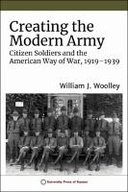Explore

The modern US Army as we know it was largely created in the years between the two world wars. Prior to World War I, officers in leadership positions were increasingly convinced that building a new army could not take place as a series of random developments but was an enterprise that had to be guided by a distinct military policy that enjoyed the support of the nation. In 1920, Congress accepted that idea and embodied it in the National Defense Act. In doing so it also accepted army leadership’s idea of entrusting America’s security to a unique force, the Citizen Army, and tasked the nation’s Regular Army with developing and training that force. Creating the Modern Army details the efforts of the Regular Army to do so in the face of austerity budgets and public apathy while simultaneously responding to the challenges posed by the new and revolutionary mechanization of warfare.
In this book Woolley focuses on the development of what he sees as the four major features of the modernized army that emerged due to these efforts. These included the creation of the civilian components of the new army: the Citizen’s Military Training Camps, the Officer Reserve Corps, the National Guard, and the Reserve Officer Training Corps; the development of the four major combat branches as the structural basis for organizing the army as well as creating the means to educate new officers and soldiers about their craft and to socialize them into an army culture; the creation of a rationalized and progressive system of professional military education; and the initial mechanization of the combat branches. Woolley also points out how the development of the army in this period was heavily influenced by policies and actions of the president and Congress.
The US Army that fought World War II was clearly a citizen army whose leadership was largely trained within the framework of the institutions of the army created by the National Defense Act. The way that army fought the war may have been less decisive and more costly in terms of lives and money than it should have been. But that army won the war and therefore validated the citizen army as the US way of war.
This book is published as part of the Sustainable History Monograph Pilot, with the generous support of the Andrew W. Mellon Foundation.
This book is included in DOAB.
Why read this book? Have your say.
You must be logged in to comment.
Rights Information
Are you the author or publisher of this work? If so, you can claim it as yours by registering as an Unglue.it rights holder.Downloads
This work has been downloaded 37 times via unglue.it ebook links.
- 37 - pdf (CC BY-NC-ND) at OAPEN Library.
Keywords
- History
- Humanities
- Military History
- Second World War
- thema EDItEUR::N History and Archaeology::NH History::NHW Military history
- thema EDItEUR::N History and Archaeology::NH History::NHW Military history::NHWL Modern warfare
- thema EDItEUR::N History and Archaeology::NH History::NHW Military history::NHWR Specific wars and campaigns::NHWR7 Second World War
Links
DOI: 10.17161/1808.32561Editions

